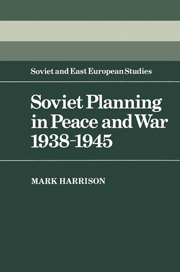Book contents
3 - THE SOVIET PRODUCTIVE EFFORT
Published online by Cambridge University Press: 29 October 2009
Summary
We must evaluate the economic efforts of each participant in the anti-Hitler coalition, first of all, not by the achieved level of output and the volume of armament produced, but by the degree of its utilisation in the course of combat. The share and significance of [their] real contribution to the attainment of overall success are determined by how effectively and purposefully the material and human resources of one or another country are utilised for the production of military equipment, and to what degree, where and when the weaponry produced is applied.
(The official Soviet history of World War II)INTRODUCTION
Germany went to war on the basis of a limited economic mobilisation. But this was a style of warfare which her adversaries could not copy. German leaders planned for speedy victories, which could be achieved without prolonged commitment or substantial losses of troops and equipment in the field. There was little special mobilisation of German industry for the invasion of the USSR, and with the invasion under way German defence production actually declined. This was a logical development, given the intention to defeat the Red Army in time for Christmas. Germany's adversaries, in contrast, could place no confidence in their chance of an early victory. Once war had broken out their only option was to subject their economies to a progressive and unprecedented mobilisation for a protracted, unlimited war. They had to fight first to deny Germany her lightning victory. Once they had successfully imposed on Germany a protracted war, they had then to mobilise further and fight to win it.
- Type
- Chapter
- Information
- Soviet Planning in Peace and War, 1938–1945 , pp. 109 - 164Publisher: Cambridge University PressPrint publication year: 1985



